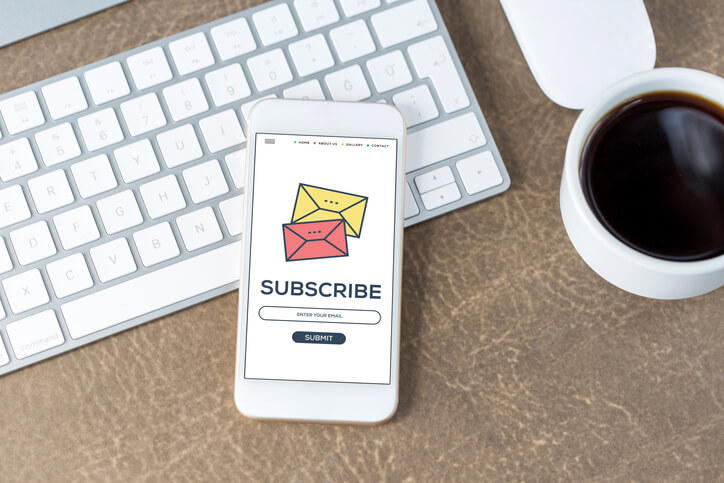Email marketing continues to be a top channel for marketers to boost customer acquisition and retention.
However, standing out in crowded inboxes can be a challenge with over 4 billion daily email users.
This number is expected to climb to 4.6 billion by 2025. There are also more than 347 billion emails sent and received each day.
With inboxes more crowded than ever, how do you ensure your emails are opened, read, and acted upon?

8 Email Marketing Tips To Win In Crowded Inboxes
Here are some email marketing tips, tricks, and strategies to help you cut through the noise and make a lasting impact.
1. Focus on Your Subject Lines
Your subject line is the first thing a recipient sees, and it often determines whether your email gets opened or ignored. In fact, 47% of email recipients open email based on the subject line whereas 69% of email recipients report email as spam based solely on the subject line.
Here are five tips to help you rock your subject lines:
- Keep It Short and Sweet: Aim for subject lines under 50 characters to ensure they are fully visible on mobile devices.
- Incorporate Numbers or Lists: Phrases like “5 Tips” or “Top 3 Reasons” can grab attention by promising concise, valuable content.
- Use Personalization: Include the recipient’s name or a relevant detail to make the subject line feel more tailored and engaging.
- Ask a Question: Questions can intrigue recipients and encourage them to open the email to find the answer. For example, “Ready for a Summer Deal?”
- Add Emojis: Carefully placed emojis can make your subject line stand out, but use them sparingly.
Be sure to also A/B test your subject lines to better understand what resonates with your audience. Even small tweaks can lead to significant improvements in open rates.
2. Segment Your Audience
Segmenting your email list allows you to send targeted messages that resonate with specific groups of people. The most effective strategies for email marketing campaigns are subscriber segmentation (78%), message personalization (72%), and email automation campaigns (71%).
To make your segmentation even more effective, try these five tips:
- Segment by Engagement Level: Target your most engaged subscribers with exclusive offers, and send re-engagement campaigns to those who have become inactive.
- Use Behavioral Data: Segment based on user behavior, such as pages visited on your website or products viewed.
- Demographics: Age, gender, and location can all be used to tailor your messaging.
- Purchase History: Tailor your emails based on previous purchases, such as recommending complementary products or offering discounts on repurchases.
- Lifecycle Stage: Create segments for new subscribers, loyal customers, and lapsed users to ensure each group receives content that meets their specific needs.
By sending relevant content to each segment, you increase the likelihood of engagement and conversions.
3. Personalize Your Content
Personalization goes beyond simply adding the recipient’s name to the email. Today’s consumers expect tailored content that speaks directly to their needs and interests. Personalized emails are 6 times more likely to drive conversions.
Here are five ways to take personalization to the next level:
- Dynamic Content: Use dynamic content to show different content blocks to different segments within the same email. For example, show product recommendations based on browsing history.
- Location-Based Offers: Customize offers or content based on the recipient’s geographic location, such as promoting winter gear to those in colder climates.
- Anniversary and Birthday Emails: Send personalized messages celebrating the anniversary of a subscriber joining your list or their birthday, complete with special offers.
- Behavior-Triggered Emails: Use automation to send personalized emails based on specific actions, like viewing a product without purchasing, with tailored messaging to encourage conversion.
- Past Purchase Follow-Ups: Send personalized follow-up emails with related product suggestions or tips on how to use what they’ve bought.
Email is considered the most personal method of brand communication by 74% of Baby Boomers, 72% of Gen X, 64% of Millennials, and 60% of Gen Z Users.
4. Optimize for Mobile
With more than half of all emails being opened on mobile devices, ensuring your emails are mobile-friendly is essential. Here are five tips to optimize your emails for mobile:
- Responsive Design: Use a responsive email template that adjusts to different screen sizes to ensure your email looks great on any device.
- Concise Copy: Keep your email content short and to the point so it is easier to read on smaller screens.
- Single-Column Layout: Use a single-column layout for a cleaner look and better readability on mobile devices.
- CTAs: Ensure your call-to-action buttons are large enough to be easily tapped on a mobile screen, and position them where they’re easy to find.
- Test Across Devices: Always preview and test your emails on various mobile devices and email clients to ensure they render correctly.
About 3 in 5 consumers check their email on the go (mobile) and 75% of say they use their smartphones most often to check email.
5. Focus on Timing
Timing can make or break your email campaign,, significantly impacting open rates and engagement.
Consider these five tips to perfect your timing:
- Know Your Audience: Use analytics to determine when your audience is most active and likely to check their emails.
- Time Zone Optimization: Send emails according to the recipient’s local time zone to ensure it arrives at an optimal time.
- Day of the Week: Test different days of the week to find the most effective one for your audience. Mid-week often works well, but your audience may differ.
- Frequency Matters: Balance your sending frequency to avoid overwhelming subscribers. Too many emails can lead to unsubscribes, while too few can lead to disengagement.
- Special Events and Holidays: Align your email campaigns with relevant holidays or events to increase relevance and engagement.
Monitor your own email analytics to find out when your audience is most responsive, and consider experimenting with different send times. 50% of marketers claim that there is no perfect time for sending email campaigns as every person and business is unique.
6. Optimize CTAs
Your email should have a clear purpose, whether it’s driving traffic to your website, encouraging purchases, or promoting a piece of content. Here are five tips for creating the perfect CTA:
- Use Action-Oriented Language: Start your CTA with a strong action verb, like “Discover,” “Claim,” or “Join,” to prompt immediate action.
- Create Urgency: Phrases like “Limited Time Offer” or “Only a Few Left” can motivate recipients to act quickly.
- Keep It Simple: Your CTA should be easy to understand and focus on a single action, like “Shop Now” or “Learn More.”
- Visual Hierarchy: Make your CTA button stand out by using contrasting colors and placing it prominently within your email.
- Test Different CTAs: A/B test various CTAs to see which ones drive the most engagement. Even small changes can have a big impact.
Limit your emails to one or two CTAs to avoid overwhelming the reader. A single, clear CTA can be more effective than multiple competing ones.
7. Use Email Automation
Email automation allows you to send timely, relevant emails based on specific triggers, such as when a subscriber joins your list, abandons a shopping cart, or makes a purchase.
Automation ensures you’re reaching your audience at the most opportune moments, without having to manually manage each campaign. Here are five ways to get the most out of automation:
- Welcome Series: Create an automated welcome series for new subscribers to introduce your brand and encourage engagement from the start.
- Abandoned Cart Emails: Set up automated reminders for customers who leave items in their shopping cart without completing the purchase.
- Post-Purchase Follow-Ups: Send automated thank you emails after a purchase, along with product recommendations or feedback requests.
- Re-Engagement Campaigns: Use automation to reach out to inactive subscribers with special offers or content to re-capture their interest.
- Birthday and Anniversary Emails: Automate emails that celebrate subscriber milestones with personalized offers or discounts.
Automated workflows like these can significantly boost engagement and conversions with minimal effort.
8. Keep Your List Clean
A clean email list is important for maintaining deliverability and engagement. Regularly removing inactive subscribers, correcting errors, and segmenting out disengaged users helps maintain a healthy sender reputation. Here are five tips to keep your list in top shape:
- Regularly Remove Inactives: Periodically purge your list of inactive subscribers to improve overall engagement metrics and maintain deliverability.
- Use Double Opt-In: Implement a double opt-in process to ensure you’re only adding genuinely interested subscribers to your list.
- Monitor Bounce Rates: Keep an eye on your bounce rates and remove email addresses that consistently fail to deliver.
- Encourage Engagement: Periodically send re-engagement emails to inactive subscribers, offering incentives to stay subscribed or update their preferences.
- Offer Easy Unsubscribe: Make it simple for users to unsubscribe if they no longer want to receive your emails. This helps maintain list hygiene and avoids potential spam complaints.
Conclusion
Winning in crowded inboxes requires a combination of creativity, strategy, and data-driven decision-making. With these tips and tricks, you’ll not only capture attention but also build lasting relationships with your audience. Happy emailing!




